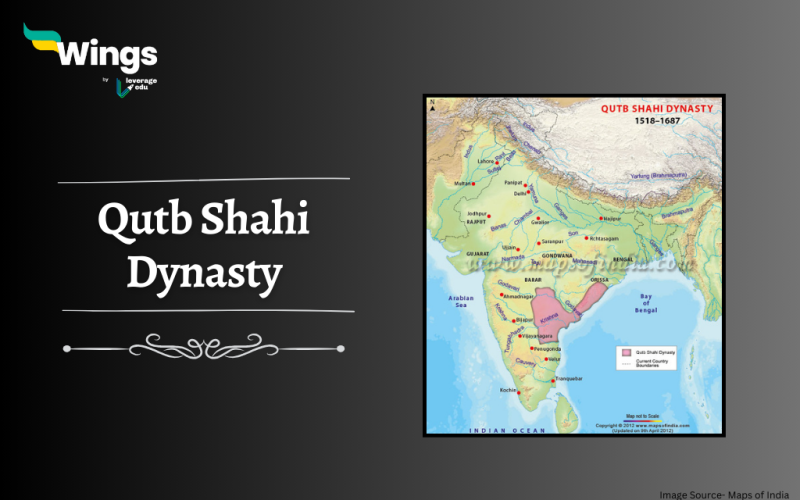The political geography of Golconda experienced noteworthy changes with the end of the Bahamani kingdom. Hence, marking the onset of a new era in historical development with the Qutb Shahi Dynasty. It was established by Sultan Quli Qutb-ul Mulk. Additionally, the Dynasty ruled over the Medieval Deccan for 171 years from 1518 to 1687 AD. Over this period, eight rulers wielded their power, thus imprinting their different personalities on the region as well as its dwellers. Moreover, the Qutb Shahi Dynasty promoted the development of a unique Deccani culture and language whilst also promoting economic growth. Read more to learn in detail abut the history, Qutb Shahi Dynasty rulers list, founder, last king, and architeture.
Contents
Who was the Qutb Shahi Dynasty Founder?
The founder of the Qutb Shahi Dynasty was Sultan Quli Qutb-ul-Mulk (r. 1518–1543). He established his dynasty after the decline of the Bahmani Sultanate in the Deccan region of South India. Sultan Quli was originally from Hamadan in Persia (modern-day Iran). He migrated to the Deccan, worked for the Bahmani Sultanate and obtained a high military rank. After the disintegration of the Bahmani rule, Sultan Quli declared independence and declared himself the ruler of Golconda.
The capital was initially Golconda. However, it was later moved to Hyderabad by Muhammad Quli Qutb Shah, the fifth sultan, who founded the city in 1591. He did this to deal with water shortages at Golconda.
What is the History of Qutb Shahi Dynasty?
In the year 1463, unrest erupted in the Telangana region within the Bahamani kingdom of Deccan. Sultan Quli Qutb-ul Mulk, a Turk who had a prominent position as a military leader under Muhammad Shah Bahamani, was sent to subdue the unrest. In addition, his efforts were successful, hence leading to his appointment as the Subedar of Telangana in 1495, with Golconda designated as his headquarters.
After the collapse of the Bahamani Kingdom in the early 16th century, Sultan Quli Qutb-ul Mulk gained independence. Consequently, this marked the beginning of the Qutb Shahi Dynasty.
Cultural Contributions:
The Qutb Shahi dynasty is popular for its architectural style. For example, you can marvel at the Golconda Fort architecture and the tombs of the Qutb Shahi rulers in Hyderabad. These structures showcase a blend of the Turkish, Persian and Indian architecture styles. Besides architecture, the dynasty emphasised literary culture. The main court langauge was Persian. However, during this period, Telugu and Urdu literature also flourished.
Economic and Social Development:
The Qutb Shahi Dynasty focused on trade links with the Middle East, Asian and Eurp. The port city of Masulipatnam became a hub for international trade. Although this was a muslim dynasty, they promoted religious tolerance. They supported Islamic scholars, and arts, and also Hindu temples and festivals
Decline and Legacy:
However, the dynasty weakened due to internal conflicts and external pressures. Externally, the dynasty faced threats from the Mughals and the Marathas. In 1687, Golconda was conquered by the Mughal ruler Aurangzeb. This marked the ned of the Qutb Shahi reign. However, even after their fall, they left a legacy through their monumental architecture, the foundation of Hyderabad’s cultural contributions.
Also Read: Hoysala Dynasty: History, List of Rulers, Administration & Decline
Who were the Rulers of the Qutb Shahi Dynasty?
The qutb shahi dynasty rulers list is provided below:
| Qutb Shahi Dynasty Rulers List | ||
| Rulers | Years Ruled | About the Ruler |
| Sultan Quli Qutb-ul Mulk | 1512 to 1543 | Sultan Quli Qutb-ul Mulk had an important part in improving the fortress of Golconda, the capital of the Qutb Shahi kingdom. 1. Moreover, he undertook many beautification projects, hence adorning the fortress with mosques, palaces, and gardens. 2. Sultan Quli laid the foundation for Muhammad Nagar, a city that swiftly gained fame as a major hub in the eastern region. In particular, it was known for its lucrative diamond and precious stone trade. 3. Additionally, he earned the admiration of his people for his compassionate rule. 4. However, at the age of 99, he succumbed to betrayal at the hands of his son, Jamsheed Quli. |
| Jamsheed Quli Qutb Shah | 1543 to 1550 | Jamsheed Quli Qutb Shah was the third son who assumed control of the government with his hands tainted by his father’s blood. 1. During the 7 years, the people held deep bitterness towards him due to his act of patricide. 2. Moreover, despite his controversial rule, Jamsheed Quli was known for his passion for poetry and education. 3. He passed away in 1550. |
| Subhan Quli Qutb Shah | 1550 to 1550 | At the age of 7, Subhan Quli Qutb Shah assumed the role of Sultan of Golconda after the passing of his father, Jamsheed Quli Qutb Shah. 1. Saif Khan, recognised as “Ainul Mulk,” was sent from Ahmednagar to oversee the regency during the young prince’s upbringing. 2. Unfortunately, Subhan Quli passed away that very year. 3. Hence leading to the ascension of his paternal uncle, Ibrahim Quli Qutb Shah, to the throne. |
| Ibrahim Quli Qutb Shah | 1550 to 1580 | Ibrahim Quli was the youngest son of Sultan Quli Qutb Shah and spent a substantial period in exile under the hospitality of the Raja of Vijayanagar. 1. During this time he learnt the Telugu language. 2. Ibrahim actively encouraged the study and usage of Telugu. His court became a hub for poets from across the Deccan region. 3. Under Ibrahim’s rule, Golconda underwent considerable advancements. 4. He encouraged construction projects within the city walls which included the erection of mosques, schools, and charitable institutions. 5. Noteworthy among his achievements are the construction of the dams at Hussain Sagar, Budwel, and Ibrahimpatnam. |
| Muhammad Quli Qutb Shah | 1580 to 1612 | During the prosperous reign of Muhammad Quli Qutb Shah, the Qutb Shahi Dynasty experienced its peak. 1. He came to the thrown at the age of 15 and is famous for his visionary leadership and the establishment of Hyderabad. 2. Muhammad Quli also promoted Telugu alongside Arabic and Persian. 3. Notably, he laid the groundwork for Deccani poetry. 4. Muhammad Quli ruled for 32 years until his demise at the age of 48 in 1612. 5. Moreover, he was regarded as a just and compassionate ruler and left a legacy as a builder as well as an intellectual. 6. His only daughter, Hayath Bakshi Begum, married his nephew and successor, Sultan Muhammad Qutb Shah, hence ensuring the Dynasty’s continuation. |
| Fascinating Fable: Legend has it that his affection for a dancer named Bhagmati, hailing from the village of Chichelam, where Charminar now stands, inspired him to rename the city Hyderabad. | ||
| Sultan Muhammad Qutb Shah | 1612 to 1626 | Sultan Muhammad Qutb Shah was known for his scholarly aptitude, religious nature as well as a deep appreciation for literature. 1. Sultan Muhammad notably initiated the Mecca Masjid, in 1617. 2. Additionally, Sultan Nagar contributed to the urban development. |
| Abdullah Qutb Shah | 1626 to 1672 | Abdullah came to the throne at the age of 12, with his mother overseeing the kingdom until he reached adulthood. 1. Moreover, his reign saw the kingdom expanding and he also faced pressure from the Mughal Empire in 1636. 2. Golconda suffered an attack in 1656. |
| Abul Hasan Qutb Shah | 1672 to 1686 | Abul Hasan also famously referred to as Tana Shah, was the son-in-law of Abdullah Qutb Shah. 1. He is known for his expert governance and determined resilience against the Mughals. 2. He was an inclusive monarch who believed in prioritising the welfare of his people above everything else. 3. Tana Shah’s reign was the end of the Qutb Shahi Dynasty. |
Also Read: Yadava Dynasty: History, Rulers, Administration & Decline
The Architecture of the Qutb Shahi Dynasty
Now that you have read the Qutub Shahi Dynasty rulers list, let’s understad the architecture they built. The details of the Architecture during the Qutb Shahi Dynasty are as follows:
| Architecture of the Qutb Shahi Dynasty | ||
| Architecture | Year | Qutb Shahi Dynasty Ruler |
| Golconda Fort | Built in 1143; fortified in 1518 | Sultan Quli Qutb-ul Mulk |
| Charminar | 1591 | Muhammad Quli Qutb Shah |
| Char Kaman | 1592 | Muhammad Quli Qutb Shah |
| Qutb Shahi Tombs | 16th and 17th centuries | – |
| Khairtabad Mosque | 1626 | Khairunisa Begum (mother of Sultan Muhammad Qutb Shah) |
| Toli Masjid | 1671 | Abdullah Qutb Shah |
| Hayat Bakshi Mosque | 1672 | Abdullah Qutb Shah |
| Mecca Masjid | 1693 | Muhammad Quli Qutb Shah |
| Taramati Baradari | 1880s | Ibrahim Quli Qutb Shah |
Who Defeated the Qutb Shahi Dynasty?
During Abul Hasan’s reign, the Mughal Emperor Aurangzeb thought about capturing the fortress of Golconda. He maintained control over it for a continuous span of eight months.
- In the year 1687, Mughal forces successfully breached the fortress. It was done by the betrayal of a collaborator who opened the gates.
- Subsequently, Abul Hasan was captured and imprisoned.
- Initially held at Bidar, he was later transferred to Daulatabad (Aurangabad) where he succumbed to his captivity after 12 years.
- Jan Sapar Khan, a prominent noble in Aurangzeb’s court, was appointed as the governor of the Deccan region under Aurangzeb’s dominion.
Thus, spanning 171 years in South Indian history, the dominance of 8 successive rulers characterised the Qutb Shahi Dynasty. Qutb Shahi dynasty rulers list consist of 8 such rulers.They each left a lasting legacy with their formidable personas. Moreover, renowned as adept builders and patrons of scholarship, they encouraged both Persian and regional Deccan cultures. Thus, was demonstrated their support for the Telugu language and the emerging Deccani idiom.
Also Read: Sunga Dynasty: Post-Maurayan Period, Achievement & More
Who was the Last King of the Qutb Shahi Dynasty?
The last King of the Qutb Shahi dynasty was Abul Hasan Qutb Shah. He was also known as Tana Shah, due to his pious and generous nature. He ruled from 1672 to 1687. He was a Shia Muslim, yet he promoted religious tolerance. He had many Hindu officials in his court, and supported Telugu and Sanskrit literature.
However, his reign coincided with the expansion of the Mughal Empire (under Aurangzeb). In 1687, Aurangzeb annexed the Golconda Sultanate into the Mughal Empire. On the other hand, Tana Shah was taken prisoner and was sent to Daulatabad Fort (in present-day Maharashtra), where he died in 1700.
FAQs
The Qutub Shahis of Golconda were a dynasty of rulers who governed the Golconda Sultanate in southern India during the 16th and 17th centuries. They were known for their patronage of arts and architecture, including the iconic Golconda Fort and the Charminar Monument.
The founder of the Qutb Shahi Dynasty was Sultan Quli Qutb-ul-Mulk. He laid the foundation for the dynasty.
The last king of the Qutb Shahi dynasty was Abul Hasan Qutb Shah. He was also known as Tana Shah.
The original capital city of the Qutub Shahi dynasty was Golconda. However, the capital city was shifted to Hyderabad later on.
The Qutb Shahi dynasty was a Shia Muslim dynasty that had its roots in Persia or modern Iran. The dynasty was known for their patronage of both Islamic and Hindu arts and culture.
Relevant Blogs
| Chalukya Dynasty | Emperor Akbar: History, Life, Achievements |
| Ajmer Fort History | Babur: The Magnificent History |
| Chera Dynasty | Chauhan Dynasty |
This blog was all about the Qutb Shahi Dynasty! If you want to read more articles like this, you can read more Short notes on the Modern History of India. Moreover, you can also visit our general knowledge page on Indian History!
 One app for all your study abroad needs
One app for all your study abroad needs














